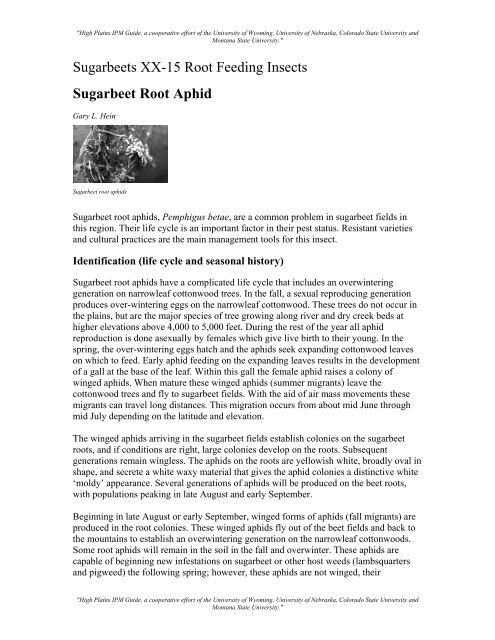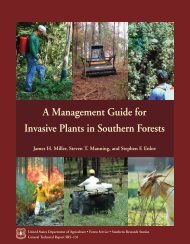Sugarbeets XX - Sugarbeet Root Aphid
Sugarbeets XX - Sugarbeet Root Aphid
Sugarbeets XX - Sugarbeet Root Aphid
You also want an ePaper? Increase the reach of your titles
YUMPU automatically turns print PDFs into web optimized ePapers that Google loves.
"High Plains IPM Guide, a cooperative effort of the University of Wyoming, University of Nebraska, Colorado State University andMontana State University."<strong><strong>Sugarbeet</strong>s</strong> <strong>XX</strong>-15 <strong>Root</strong> Feeding Insects<strong>Sugarbeet</strong> <strong>Root</strong> <strong>Aphid</strong>Gary L. Hein<strong>Sugarbeet</strong> root aphids<strong>Sugarbeet</strong> root aphids, Pemphigus betae, are a common problem in sugarbeet fields inthis region. Their life cycle is an important factor in their pest status. Resistant varietiesand cultural practices are the main management tools for this insect.Identification (life cycle and seasonal history)<strong>Sugarbeet</strong> root aphids have a complicated life cycle that includes an overwinteringgeneration on narrowleaf cottonwood trees. In the fall, a sexual reproducing generationproduces over-wintering eggs on the narrowleaf cottonwood. These trees do not occur inthe plains, but are the major species of tree growing along river and dry creek beds athigher elevations above 4,000 to 5,000 feet. During the rest of the year all aphidreproduction is done asexually by females which give live birth to their young. In thespring, the over-wintering eggs hatch and the aphids seek expanding cottonwood leaveson which to feed. Early aphid feeding on the expanding leaves results in the developmentof a gall at the base of the leaf. Within this gall the female aphid raises a colony ofwinged aphids. When mature these winged aphids (summer migrants) leave thecottonwood trees and fly to sugarbeet fields. With the aid of air mass movements thesemigrants can travel long distances. This migration occurs from about mid June throughmid July depending on the latitude and elevation.The winged aphids arriving in the sugarbeet fields establish colonies on the sugarbeetroots, and if conditions are right, large colonies develop on the roots. Subsequentgenerations remain wingless. The aphids on the roots are yellowish white, broadly oval inshape, and secrete a white waxy material that gives the aphid colonies a distinctive white‘moldy’ appearance. Several generations of aphids will be produced on the beet roots,with populations peaking in late August and early September.Beginning in late August or early September, winged forms of aphids (fall migrants) areproduced in the root colonies. These winged aphids fly out of the beet fields and back tothe mountains to establish an overwintering generation on the narrowleaf cottonwoods.Some root aphids will remain in the soil in the fall and overwinter. These aphids arecapable of beginning new infestations on sugarbeet or other host weeds (lambsquartersand pigweed) the following spring; however, these aphids are not winged, their"High Plains IPM Guide, a cooperative effort of the University of Wyoming, University of Nebraska, Colorado State University andMontana State University."
"High Plains IPM Guide, a cooperative effort of the University of Wyoming, University of Nebraska, Colorado State University andMontana State University."movement is limited, and they are not likely to move to new sugarbeet fields. Avoiding aclose rotation of sugarbeet and controlling lambsquarters and pigweed in rotated cropswill lessen the potential for problems from root aphids that overwinter in the soil.Plant Damage and Response<strong>Root</strong> aphids feed primarily on the secondary roots of the sugarbeet; however, heavyinfestations may be found covering the surface of the beet. Their feeding interferes withnutrient and water uptake and transport. Severe infestations in association with plantstress (i.e. drought) can cause leaf yellowing and wilting. <strong>Root</strong> aphid damage will resultin reduced sugar percentage and tonnage losses to sugarbeet. Recent research in thisregion indicates that even moderate populations of root aphids, where no above groundsymptoms are evident, can result in significant sugar losses (up to 30 percent) onsusceptible varieties. Additional stress, such as drought or disease, will increase theimpact of the aphids.Management ApproachesThe best option for managing the sugarbeet root aphid is the use of resistant varieties.Recent testing of sugarbeet varieties has shown that many varieties have excellentresistance to the aphid in the field, and susceptible varieties can be severely impacted bythe presence of aphids. Most sugarbeet seed companies have lines with excellentresistance to the aphid. Testing has been done to determine resistance levels for regionalvarieties; however, not all varieties grown in the region have been evaluated. Sugarcompany or seed company representatives should have the most current information onvarietal responses to root aphids. If varieties are showing a considerable presence ofaphid colonies in the fall as indicated by the extensive presence of the white waxymaterial in the colonies and sugarbeet yield or quality is reduced, these varieties shouldbe avoided, if possible. In determining varietal response to aphids, it is important toinspect multiple beets. Some varieties show a segregating response where individualplants will vary in their resistance to the aphid. Some of these varieties have been shownCultural practices also will reduce the risk of problems from the sugarbeet root aphid.Avoiding a close rotation of sugarbeet and maintaining good control of lambsquarters andpigweed in rotated crops will lessen the potential for root aphids overwintering in thesoil. If this is done, reinfestation will need to occur from migration from narrowleafcottonwoods. Spring migrations to sugarbeet fields throughout the region are likely tooccur each year, although the level of migration may vary from year to year. The extentof the problem will depend on several factors that affect both aphid survival through thewinter and spring and the weather patterns during and following migration. Properirrigation during the latter half of the season will reduce stress on the sugarbeet plants andreduce the impact of the aphid. Of particular importance is late season irrigation (lateThere are currently no registered chemical controls that are effective in consistentlycontrolling sugarbeet root aphids."High Plains IPM Guide, a cooperative effort of the University of Wyoming, University of Nebraska, Colorado State University andMontana State University."
"High Plains IPM Guide, a cooperative effort of the University of Wyoming, University of Nebraska, Colorado State University andMontana State University."Categories: Insects, <strong><strong>Sugarbeet</strong>s</strong>, <strong>Root</strong> <strong>Aphid</strong>Date: 04/19/2006"High Plains IPM Guide, a cooperative effort of the University of Wyoming, University of Nebraska, Colorado State University andMontana State University."
















